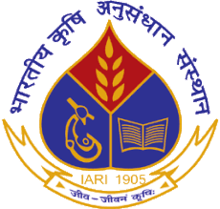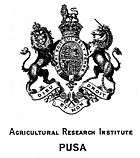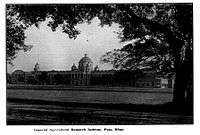Indian Agricultural Research Institute
The Indian Agricultural Research Institute (IARI), commonly known as the Pusa Institute,[3] is India's national Institute for agricultural research, education and extension. The name Pusa Institute is derived from the fact that the institute was originally located in Pusa Bihar as the Imperial Institute of Agricultural Research in 1911. It was then renamed as the Imperial Agricultural Research Institute in 1919 and following a major earthquake in Pusa, it was relocated to Delhi in 1936. The current institute in Delhi is financed and administered by the Indian Council of Agricultural Research (ICAR). The IARI was responsible for the research leading to the "Green Revolution in India" of the 1970s.[4][5]
 | |
| Abbreviation | IARI |
|---|---|
| Formation | 1 April 1905 |
| Purpose | Agricultural research and education |
| Location |
|
| Coordinates | 28.080°N 77.120°E |
Director[1] | Dr. Ashok Kumar Singh [2] |
Parent organisation | Indian Council of Agricultural Research (ICAR) |
| Website | www |
Formerly called | Imperial Institute of Agricultural Research |
History


The institute was established in 1905 at Pusa, Bihar, with the financial assistance of Henry Phipps, Jr., an American philanthropist. Phipps was a family friend of Lady Curzon, the daughter of an American millionaire, and the wife of Lord Curzon, the Viceroy of India. Phipps stayed as a guest of the Curzons during his visit to India. More importantly, Phipps left behind with them a donation of $30,000, which was used to establish the institute. He laid the foundation stone of the Agricultural Research Institute and college on 1 April 1905.[6] The Institute was originally called the Agricultural Research Institute (ARI). Its name was changed to the Imperial Institute of Agricultural Research in 1911, and to the Imperial Agricultural Research Institute in 1919.[3] A reason for establishing it in Pusa in northern Bihar was the proximity to the indigo plantations which were in need of revival after the German synthesis of aniline in 1899. One of the first scientists to be deputed to the institute was the English chemist John Walter Leather in 1892.[7][8]
However, the institute was damaged during the devastating Bihar earthquake of 15 January 1934. The Secretary of State approved the transfer in July, 1934.[9] The Standing Finance Committee of the Union Assembly finally announced on 25 August 1934 in Shimla, the decision to shift the institute to New Delhi at the approximate cost of ₹3.8 million (US$53,000).[10] to a place that is now called Pusa in New Delhi. B. Viswanath was the Director at that time. He also happened to be first Indian Director of IARI. The new campus at New Delhi was inaugurated on 29 July 1936,[3] while the new building of the Imperial Institute of Agricultural Research was inaugurated by the then Viceroy of India, Lord Linlithgow on 7 November 1936.[11]
Post-independence: 1947–present
| Bernard Coventry | 1904–1905 |
| E.J. Butler | 1920 |
| William McRae | 1929 |
| W.H. Harrison | 1929–1930 |
| William McRae | 1931–1934 |
| Bernard Keen | 1930–1931 |
| F.J.F. Shaw | 1934–1935 |
| B. Viswanath | 1935–1944 |
| H.S. Pruthi | 1944–1945 |
| J.N. Mukherjee | 1945–1950 |
| B.P. Pal | 1950–1965 |
| A.B. Joshi | 1965–1966 |
| M.S. Swaminathan | 1966–1972 |
| A.B. Joshi | 1972–1977 |
| H.K. Jain | 1977–1984 |
| A.M. Michael | 1986–1990 |
| S.K. Sinha | 1991–1994 |
| R.B. Singh | 1995–1999 |
| Panjab Singh | 2000–2002 |
Post-independence, the institute was renamed the Indian Agricultural Research Institute,[3] and in 1950 the Shimla sub-station of institute developed Rust-resistant varieties of wheat, including Pusa 718, 737, 745, and 760.[12] In 1958, it was recognized as a "deemed university" under the UGC act of 1956[13] of Parliament and since then it has awarded MSc and PhD degrees.[3]
What remained of the institute at the original location was downgraded to an agricultural research station until 1970, when the Government of Bihar established the Rajendra Agricultural University at the location.[6]
Overview
It will serve the cause of science and society with distinction through first rate research, generation of appropriate technologies and development of human resources. In fact, the Green Revolution was born in the fields of IARI and its graduates constitute the core of the quality human resource in India's agricultural research and education. The Institute has all along been adjusting and improving its policies, plans and programmes to effectively respond to the needs and opportunities of the nation. During the fifties, the advancement of scientific disciplines constituted the core programme and provided the base for its fast expansion in the 1960s and 1970s in all its three interactive areas, namely, research, education and extension. Besides basic research, applied and commodity research gained great importance resulting in the development of several popular high yielding varieties of almost all major crops and their associated management technologies, which brought about an unprecedented increase in the national food and agricultural production.
The campus is spread over 500 hectares (5.0 km2), 8 km west of New Delhi Railway Station. This was initially outside Delhi, but over the decades the city has grown much beyond the campus.[14] Indian Agricultural Statistics Research Institute is affiliated with and is located in the campus of the Indian Agricultural Research Institute.[15]
Schools at IARI
- School of Crop Improvement[16]
- School of Plant Protection
- School of Basic Sciences
- School of Natural Resource Management
- School of Social Sciences
- School of Horticultural Science
See also
- Pusa 1121 rice
- Van Vigyan Kendra Forest Science Centres
References
- "Administration". Retrieved 13 September 2013.
- "Director". www.iari.res.in. Retrieved 8 March 2018.
- "About IARI". Retrieved 13 September 2013.
- "History of Research in Indian Agriculture". Indian Agricultural Research Institute. Archived from the original on 24 August 2007.
- "'Pusa Institute' is still the best". The Times of India. 30 September 2001. Retrieved 13 September 2013.
- "About Pusa". Rajendra Agricultural University, Pusa Samastipur , Bihar. Archived from the original on 29 July 2013. Retrieved 13 September 2013.
- Borthakur, Anwesha; Singh, Pardeep (2013). "History of agricultural research in India". Current Science. 105 (5): 587–593.
- Mukherjee, S.K. (1992). "Progress of Indian agriculture: 1900-1980". Indian Journal of History of Science. 27 (4): 445–452.
- "Pusa Agricultural Research Institute". The Indian Express, Madras. 4 July 1934. p. 1. Retrieved 13 September 2013.
- "Pusa Institute To Be Removed To Delhi". The Indian Express, Madras. 27 August 1934. p. 1. Retrieved 13 September 2013.
- "Agricultural Research Institute Building Opened". Indian Express. 9 November 1936. p. 2. Retrieved 13 September 2013.
- "Rust-resistant Wheat Varieties .Work At Pusa Institute". The Indian Express. 7 February 1950. Retrieved 13 September 2013.
- "UGC Act-1956" (PDF). mhrd.gov.in/. Secretary, University Grants Commission. Retrieved 1 February 2016.
- "Our Campus". Retrieved 13 September 2013.
- "Origin & Growth". Indian Agricultural Statistics Research Institute. Retrieved 13 September 2013.
- "Schools of IARI". Retrieved 13 September 2013.
External links
| Wikimedia Commons has media related to Indian Agricultural Research Institute. |